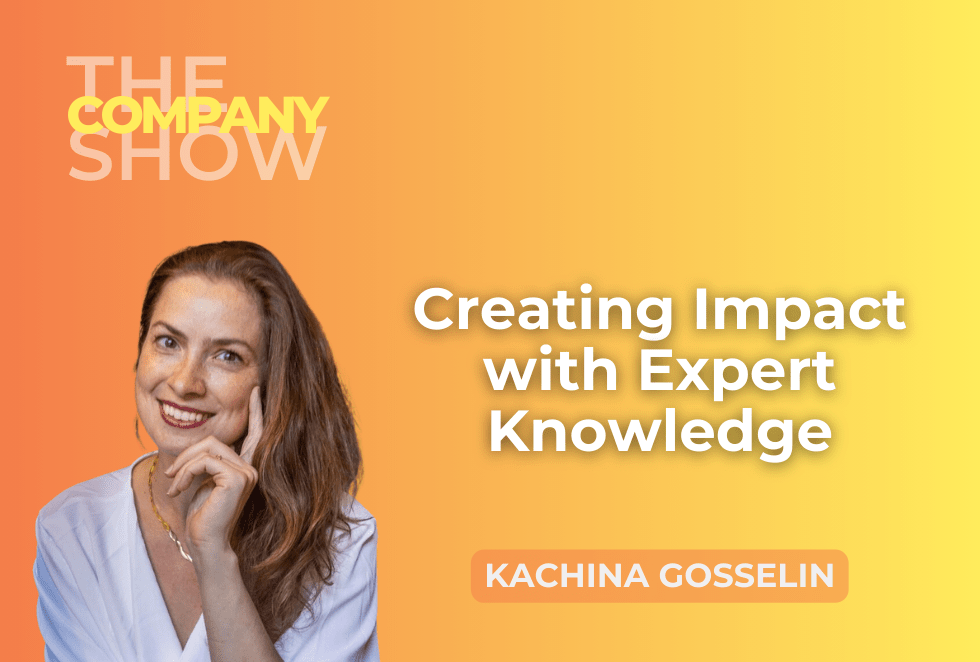Stop me if you’ve heard this one: I want to develop a passive income stream. You’ve heard it; you might have thought of it—I definitely have.
But I’ve also been in the Internet marketing industry long enough to know that while evergreen, scalable monthly recurring revenue is possible and can over time be largely automated, passive is at best an exaggeration of the work involved in keeping that kind of machine turning—and at worst a damn dirty lie to sell you a quick fix.
When people think of passive income or, more realistically, scalable evergreen product-based income, courses are usually at the top of the list. Creating a course is treated like getting your very own golden goose that’s going to lay profit eggs for you every single month.
The thing is, it can work and be an amazing way to scale your business, serve more people, and make a bigger impact in the world. But it is not a fit for every business, and it is not a fit for every stage of every business.
My guest today understands that and has built the criteria for success with courses into every level of her own company. And she has some very interesting thoughts on how podcasts and scalable products like courses and group training programs can work together.
Kachina Gosselin is the founder of Founders Path. She graduated from MIT with a degree in aeronautics and astronautics and now specializes in helping experts monetize their expertise and thrive in the creator economy.
If you want to leverage your expertise and generate more impact, listen to the episode below or continue reading the blog post!
Tune in to the full episode to learn about:
- How experts can turn into course creators
- The importance of pricing
- When should you create your own course?
- The related costs and investments
- The quality standards that you must meet
- The intersections of podcasting and courses
Don’t forget to join us for our free monthly strategy calls on the third Thursday of every month!
Kachina Gosselin: Helping Experts Monetize Their Knowledge
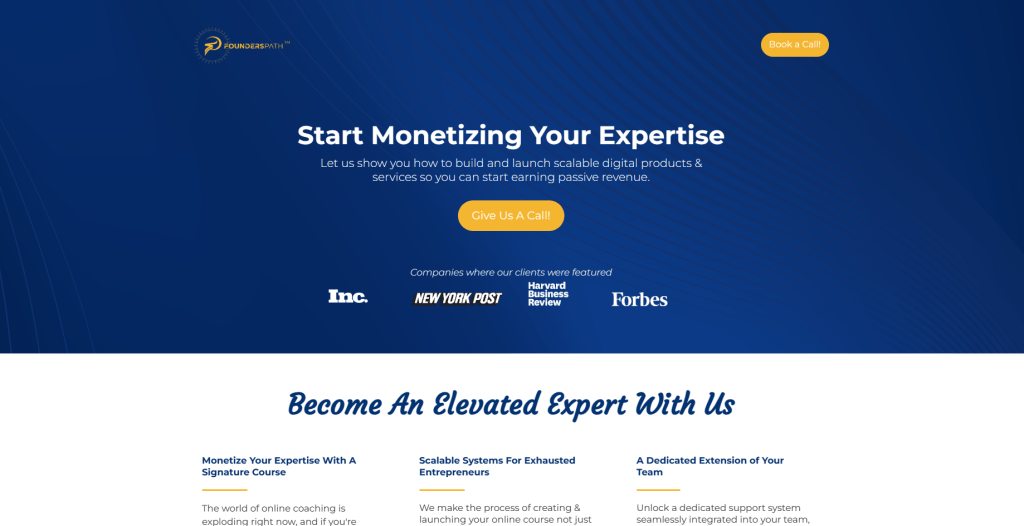
Kachina: “We help expert coaches build online courses, and I like to say that the emphasis is on experts. There’s a lot of coaches right now flooding the market, and so we want to work with experts, and they tend to be best-selling authors, professional speakers, and established podcasters. They’re people who’ve proven that they can build a body of work, and what they’re trying to do is figure out how to monetize that.
Typically, they come from a very successful corporate or academic career, and they know that what they have to share is of value, but they don’t necessarily know how to package and price it properly.
And the dream is, if you really understand online business and online marketing, you can have an expert and sell what you know, and you can package it at price points ranging from $27 up to $25,000 or more.
But very often, because what we know is so ethereal and it’s so inherent to our lived experience, we have trouble really pulling it out of thin air and turning it into something tangible, and that’s something that people will value at its appropriate worth through online and digital media.
So, what are you really selling when you’re conveying what you know? And so we started off this business by doing online courses. So they’d typically be the evergreen video course, kind of that talking head style where you’re building authority and you’re sharing what you know, and we price those at one to two thousand dollars.
We see it as part of a multi-tiered revenue stream. So there’s multiple products and services around a core expertise, because we know as business owners, to be too scattered is so stressful. So you want to have one core expertise, you’ve built that up over the course of your lifetime, you’ve built up a body of work.
But now you’re trying to say, how can I convey this at a price point of $1,000? How can I convey this at a price point of $10,000? What if that’s not accessible and I want to scale it, really talk about volume. Typically, you might want to offer some lower priced products just because even the sales cycle for high-cost products is so complicated.
So what that did is it created a space, we’re in this creative industry, creative economy, where people are teaching what they know and what they’re trying to do is pull out; Is it a lead magnet? Is it a video? Are there Zoom calls? How do I deliver it? Is there a retreat and physical in-person component?
And there’s an answer to all of those questions, you just have to speak to people who talk, who sell these programs and build these programs. And what I found from entering the online course industry is a lot of marketers are out there and they’re really, really good at selling. So they go, Oh, don’t worry about it, just sell it. Slap a $10,000 price point on it. Sell it. Build it, once you’ve made a couple of clients.
If you’ve ever gone through that experience either on the receiving end or been coached in that way, you’re like, I don’t want to know that if I’m building a program that people will perceive at the same value that I perceive it—that it actually exists.
And so we do a lot of that work of how do you build a group coaching program, a mastermind, a course? What are the differences between those programs and which one is appropriate? Because they’re part of this sales funnel and a lot of coaches, the reason why a lot of coaches aren’t successful is I’ve seen so many beautiful lead magnets, beautiful branding, excellent lessons, so much content given away for free.
So it’s growing the coach’s email list, but they’re struggling. They’re kind of like a starving artist, and you don’t want that. So I’ve seen so many coaches build up these beautiful bodies of work and might be podcast episodes, hundreds of episodes of podcast episodes they pour their heart into, they’re like, Okay, but where’s the monetary gain? Because I need to feed myself, need to feed my family.
And if they have a support team, there’s certainly the pressures of payroll and just managing a company.”
Prioritizing Value in Creation and Pricing

I love the emphasis that Kachina is putting on here, of building the thinking around the price and the value of what you’re creating as part of the creation process. Because I’ve seen all over the industry, the price is an afterthought.
Maybe even you’ll sign up for a program to build a course that’s going to sell for $997 before you even get into what is going to be contained within it. I love that sort of structural and value-based approach.
But how should people think about these kinds of programs?
Kachina:
”There’s certainly a chicken and egg between so many people talk about money mindset, and so very often you’re like, It’s my money mindset. It’s my problem. But they don’t actually talk about, No, when we package things this way, they’re perceived at a higher value, but the value is built into the delivery mechanism.
When somebody swipes their credit card and then they get an onboarding sequence, it starts to feel real what is usually just very ethereal, which is I’m really good at what I do, and all I need to do is get in front of the right person and they’ll know it.”
When should you create a create your course or group program?
Kachina: “When we pivoted into this part of the business, we did go straight into course creation it was something I was able to master really quickly.
I spent over $50,000 in courses that I had purchased myself and like we talked about various degrees of quality independent of the price. Like the price tag could be really high and the quality really low and vice versa.
So we got into creating the online evergreen courses initially and when a client comes in with a significant body of work, lots of podcast episodes, a written book, that can be fairly easy, but it skips the step that most people often talk about, which is validating the market.
And so what we encourage our clients to do is launch a group coaching program and verify that they have a cloneable client, that they have a program promise, and then we can develop a curriculum, reverse engineer all of the assets we would need to then produce an evergreen product.
But we take a lot of that pressure of recording a video that nobody sees that you know is valuable but you haven’t answered any Q a questions around it. All of those things that I think we’re going to talk about how you can also use podcasts in the absence of that group coaching program to maybe air some of those ideas and get some public feedback.
So typically we do have some harder metrics now of where we want a client to be. So before you diversify revenue streams, you want your existing ones to work. So we typically don’t recommend an online course unless you’re six figures or more into your coaching business.
And then I’d like to see at least 50,000 of that come from a group coaching program. So those can typically be anywhere from $3,000. So it’s typically around ten to 20 sales.”
Considerations for Developing Evergreen Content for Group Coaching Programs or Evergreen Courses
Megan: If you’ve been in the Internet marketing world, especially at all, it’s like the course is the thing you have to have. And thank you very much for the benchmark of when you can actually consider it.
For years I’ve been saying, if you want an evergreen course, you have to have clients that would love to work with you but can’t. People should be asking you for one and just being able to prove the demand before investing all of this time and money.
Creating a really good, high quality evergreen content, it’s not a small project, it’s a lot of work. So what kind of time and resources should people be planning to invest if they are going to pursue this kind of strategy for the group coaching programs or for a more evergreen course?
Kachina answers this below:
The Cost and Value of Creating a Signature Course
Kachina: “I don’t want to be intimidating at all, but I think we do just have to acknowledge those harsh realities, that a course is a really advanced product to sell. We design a program to be three months, but we understand creative effort is challenging. We plan for productive procrastination. So it’s typically a three to six month framework to create a signature course.
So we start with a core concept of a signature course and we’re really, really dialed in on what that outcome is. It’s a six-module framework that’s designed to be delivered over six weeks self-study or three months in that group coaching format.
So now we help people transition from one to the other. What you’ll know it’s a five-figure investment, it’s $30,000 and more right now for our agency. And here’s the thing that sounds like so much.
If you go into the creator industry and you start calling up videographers and looking up studios, just the cost of reserving time in a studio is 10-15 thousand dollars a day. And the amount of studio time you need for a six-module course of the framework that we build is about two and a half days.
So it’s a significant investment. Imagine you go to the studio and you haven’t talked through the curriculum and you haven’t built out the sales page, and you’re not actually really confident about some of those delivery mechanisms, then you might stumble and you might have to pay more just in re-recording.
You’re going to have to depend on the videographer who isn’t a curriculum specialist to guide you through a process when you really want to do all that preparation, business model development, which is where we start.
We want to make sure that it’s the right time and place for the course. So it’s comparable to the professional videography studio, but it’s got so much more support around validating the idea, building the sales assets, building it into your business model, and those checks and balances really help make sure that you’re making the investment at the right time.”
Standards for Creating Quality Content
Megan: Let’s dig into some more of those elements. So I’m really happy that Kachina provided the benchmark for the incredibly high work equality work that your company does.
When you put, say, like a $30,000 mandate in the context of, Well, no, if you’re a business that’s doing more than six figures, and half of that is already coming from validated content that you’re selling through group programs, that’s a very wise investment.
Talk about some of the things that are into that, because some people are going to want to work with a company like yours to build this. Other people are going to go a little more DIY, at least maybe for the first round or as they’re getting started.
And so Kachina mentioned a couple of things I’d love to explore a little bit more in terms of their importance, especially in being able to communicate the value like you were talking about earlier, because this is something that’s really similar in podcasting.
There’s table stakes for how you look and how you sound when you’re creating this kind of content and you have to be really mindful of hitting those kind of industry-level standards.
What are some of the standards people should be trying to approach when they’re creating this kind of content? Kachina talks about this below—this applies to your podcast as well.
The Standard: Create a Multimedia Learning Experience
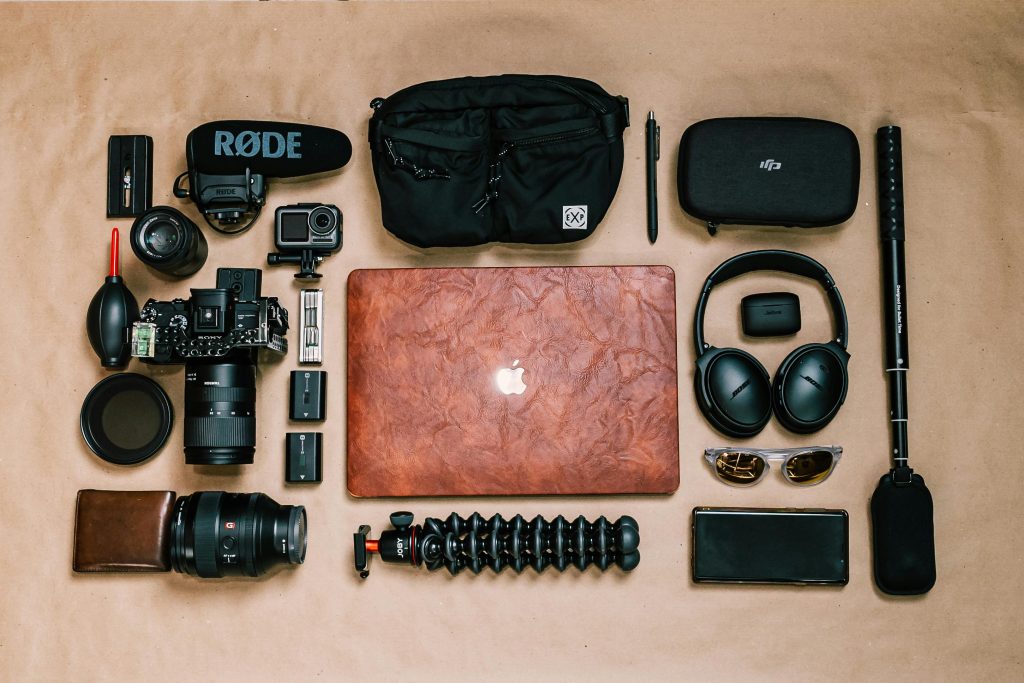
Kachina: “I’m probably going to ramble a little bit because there’s a lot here about what goes into a quality course.
1. Multi is the way to go
“So, first of all, I think the thing to acknowledge is that it’s multimedia. There are so many video courses and they stop there, and then there are very few courses that are just written content. The best thing to do is just to go in and know that this is a multimedia experience.
And while there is some science behind, we’ve all heard there’s kinesthetic learners and audio learners and visual learners, ultimately, most humans do better with all of these things.
And when you’re building a course, you’re trying to increase income and impact. So you have to assume that you’re not going to know the learning styles of your client because you may never meet them. And so we want to create a multimedia experience to hit all of those brain centers and that scientifically is proven to increase your tension.
So knowing that you’re coming in, you’re going, I have to get comfortable on video? This is one of the reasons why we love working with podcasters and speakers. They’re so much more comfortable.
They’re not going to get anxious because they don’t like the sound of their own voice. They understand how to be more conversational and kind of flow between points. So that’s great and that’s really essential.”
2. Mind the resolution
“The video quality, we have video coaches, but it’s really what we have right here, quiet space, not a lot of distractions. You can start with just a simple, I think I have a Logitech camera. We don’t try to over engineer these things. What we want you to do is feel really confident in the material.
And actually, one of the reasons why they like video coaching clients in their own home is we want them to get comfortable producing content when they have an idea as to post it, getting their makeup done, and then turning it on, and then stopping, starting over and over again and overanalyzing.
So a lot of creators, we get into creative blocks. We want to make sure that creative tasks feel really natural and are at a good production value enough that it’s not going to hurt the reputation of your business.
We have clients—I think one of the stories recorded a video in Panera. Okay, sit down in a quiet room. No distractions. But it’s not $5,000 of equipment, it’s your comfort on video.
When we ask them to write lessons, very often we’re asking them to write less, not more. So you want to be conversational, it has to come from you, it has to be your tone. But it’s less, not more. These aren’t books. They shouldn’t feel too cumbersome.
And then with the workbooks, same thing. Less is more. I used to make these things as like, huge academic journals. We’re not in college courses. Even when you’re producing highly quality video courses, you want them short, succinct, conversational.
Somebody might not even be tuning into the visuals. We know that people listen to audio a lot more. They want that on the go feel, they don’t want to have their eyes locked to a screen all the time.
So it’s short video content without a lot of extra visuals. Maybe just enough to retain attention. But really just to make sure that you can look away, you can engage with your kids, you can take a break, you could be driving, it’s safe.
Because people only have so much time. They want to go through a course in one to 2 hours a week and that’s going to include the homework assignments.”
The Cafe Dilemma
Megan: I just want to share a similar story. This is from podcast World, about the recording in a cafe.
This was a podcast that was going to be about cafe businesses. Very appropriate. It was almost like a knockdown layout fight about whether they could be recorded in the cafe or recorded in a studio with cafe sounds added afterwards.
And the answer is, recorded in a studio with cafe sounds added afterwards. There is no excuse for uncontrolled background noise. That’s as true in courses as it is in audio.
Investing in Quality for Impact
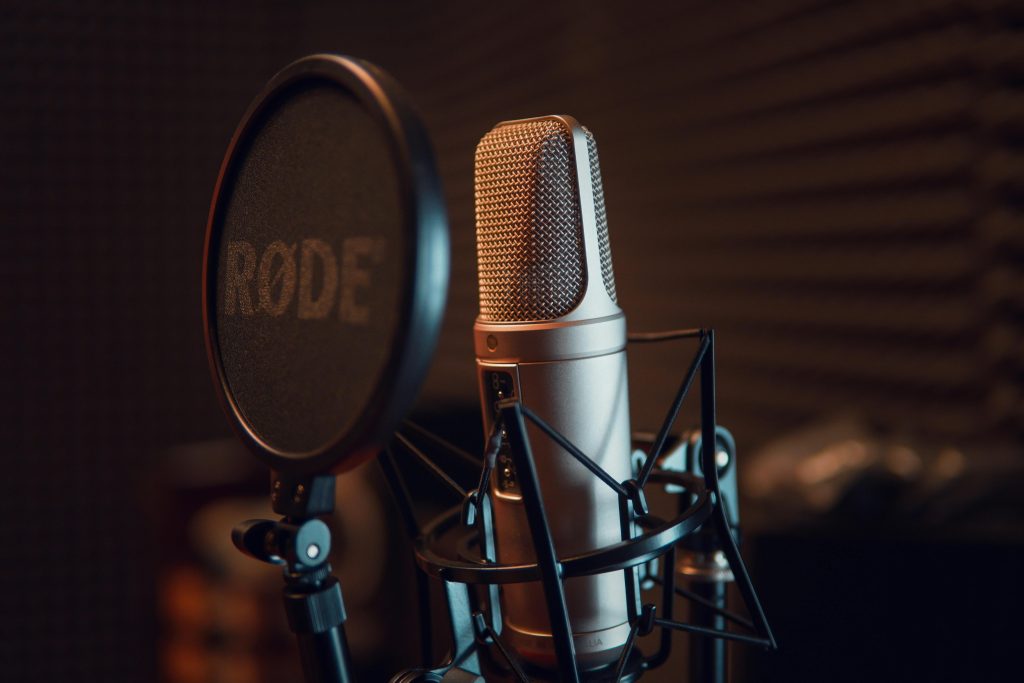
Kachina: “Audio quality is a major reason why people don’t continue listening to podcasts, so the same thing is true in our video courses.
And this is why people are willing to invest so much on the quality of the course—they know that they know just enough to get it done, but not well, and they don’t want their perception of their business be negatively impacted because they weren’t willing to go just the extra mile, upgrade their mic, upgrade their camera.
And sometimes you’re making so many decisions, you just need an expert, Go, it’s enough. Just press start. Because that’s what we often happen. Actually, I’m writing a book called The Expert’s Dilemmas, and one of them is just that analysis paralysis.
Everybody gets into writer’s block, but nobody gets into talker’s block. There are these small things that you just need in place to let that creative energy flow, because we’re surrounded by creative energy all the time. And sometimes it’s just having somebody in your ear saying…
You look good, you sound good. Ignore that you hate the sound of your own voice, because there’s psychological reasons why that’s true. And just trust us, we’ll make you look good after the edit. You’re going to be fine.”
The Importance of High-Quality Audiovisual Standards
Megan: As a podcast producer, I won’t actually have you repeat it, but again, for the people in the back, that is exactly true.
And I think something that’s not talked about as much as it should be is the importance of this kind of table stakes quality, the standard for what is expected for an audiovisual product. It’s getting higher every year.
There are fewer and fewer excuses and I think a lot of experts, aided and abetted and terribly misled by many other coaches and businesses out there, will say, Oh, no, you can just turn on your camera and start recording. It’ll be fine. You don’t need to have good quality audio.
You need to have good quality materials. This is your business. This is a professional work product, and you really do lose credibility. You can have the best content in the world, but if you sound like you’re recording in a tin can, or if you’re using a webcam that looks like it’s from, say, 2010, it’s not going to go well.
No one’s going to say, Hey, I took this great course, they’re going to say, Actually, I’m not going to tell anyone about this at all, because it’s just not meeting the needs it must.
Maximizing Impact through Podcasting
Kachina: “A lot of my clients, like I talked about, they’re experts at what they do and typically, when they come to me, they’re looking to move from one-on-one work, which is really time intensive to one to many.
So they’re really starting to focus on impact. And when you focus on impact, you’re trying to figure out how to get your message to land with a wider audience. And so there’s so much from podcasting that’s going to help.
One, you’re like audience building. You’re building a relationship with people. You’re also refining your concepts. And so I initially see podcasts like they’re authority building machines, but there are a lot of micro decisions, and I think that’s where you could weigh in.
It’s like, do you do an interview style podcast? Well, that could be really good for growing your network but one of the things I’ve heard from clients that have done two solely interview based podcasts is that they’re not really establishing themselves as an authority.
So you might want to mix in some of those kind of more succinct, I’m going to teach some frameworks, and then the question goes, Are you teaching so much? And even though I’m in the education industry, even though we recommend a high-cost product and we build out courses, we never really recommend a course being under $1,000 because we want to set perceived value as high.
We do believe in the value of the product that you can give away most of what you’re teaching in your course, because the podcast framework and the social media, it’s not enough for somebody to actually get the work done right.
So often we’re not charging for the education as much as even though we’re in the education industry, we’re charging for impact. And that usually requires additional layers of accountability support. Typically, the course content is available in little snippets on the client’s social media content.
And yet what people are getting is they’re getting all those bonuses. What are the scripts, what are the cheat sheets, the checklists, the things that are actually going to make sure that I go from idea to action. So ideas are cheap. Action is priceless.
And so you can give away a lot in those authority building episodes. But what we’ve also found, and I can give an example of, like, there’s a podcast host that I listen to, she’s amazing. She does so much education in her podcast, but all of her education is around sales objections. And even though I say that these are highly valuable.
I think I’ve listened to over 200 episodes, and I can tell you that because she’s answering my sales objections and she’s educating me, when I go to buy her product, which I believe I will, I’m going to go straight past any of her low-cost products, past her $1,000 course, and I’m going to go straight into her $15,000 program.
Because what she’s done is she hasn’t held back, and she has supported me, and she’s done so in that very relationship building. Like, when you listen to somebody in podcasts, it’s like you feel like you know them. They have absolutely no idea who you are. So I feel so close to her. She’s helped me through so many challenges.
I’ve sat there going, Maybe that’s the pivot I need to make in my business. And that trust is built. I’m going to buy into that higher cost product when I’m ready. So that’s, I think, the challenges, interview or solo? What are you really teaching? How much can you give away?
There are so many nuanced questions around that. So I do love the pairing of the two.”
Building Trust Through Podcasting

Megan: I love the way Kachina is approaching this, and this is why I’m happy to recommend people to her, because I think we really have similar values in terms of how this content should be created and consumed.
I have an almost exact analog to the story Kachina told about this podcaster that she’d been listening to, whose course maybe she will buy because she’s been able to skip all of those steps.
The knowing, liking, and trusting has been established, and we see that within a lot of our clients as well, especially for shows where their high trust factor is required in finance, in legal and healthcare.
Someone who listens to a podcast host, an expert, a provider of these services, if you listen to them for even six, ten, twelve episodes. Well, all of a sudden, when you go into that sales conversation, you’re ready to go.
And we’ve seen this in our clients and they are producing this content and their sales team is saying, Listen to these episodes before your discovery call. This is the person you would be working with.
And then they get on that call and it’s not, Should we work together? It’s, When can we start? Because the work has been done. And I think that’s so powerful. It’s a type of value that’s hard to track, it’s hard to attribute, it’s hard to know that’s happening, but it is.
And I love that that is as true in something like a course as it can be in something like audio. And I also really like what Kachina is saying—you can give away basically everything.
Because you can go on the Internet and learn absolutely anything that you want from a bunch of sources. But we’re not all multimillion-dollar business owners because actually doing the work requires structure and support and accountability and all of these things and adding that to the value of the course, I think is fantastic.
And what I also like about that is it kind of gives you the freedom from a creative standpoint. You can work out your content in your podcast. You can start testing out the ideas, see how they land, see how it feels to communicate them, try communicating them in different ways. Pick the ones that did best.
If you want to maybe talk about a lesson in a podcast several different ways over, say, a six-month period, pick the episode that performed the best. That’s what goes into your course, because you know the content is going to land well with your audience.
You’re not risking people not buying your course because they’re not just buying the information. I love ideas are cheap, that’s the perfect way to kind of describe that. It’s the action and the doing things that is so much more.
The Curse of Knowledge: Simplifying Expert Ideas for Audience Connection
Kachina: “And yet the challenge, and this is what I do with my clients, is ideas are cheap. And this is coming back to me, his is something I’m actively working on, is simple, is not easy.
And so a lot of our clients, when you’re an expert, you actually have this thing, it’s called the curse of knowledge. And so you’re less likely to identify with your audience at the earlier stages of your journey, not only because it was so long ago, but it’s also kind of boring for you.
And so you’re kind of like, Oh, I want to give them these golden nuggets and if I give them this, they’ll understand everything. You could hand them to them and it’ll look like coal. They just be like, What is this? I don’t get it. Tell me what I need to know.
And so a lot of the challenge for an expert is to create content and connect back to their audience at the stage that they’re ready to consume that information. And so it’s getting simple. And so it’s very important whether it’s in a group coaching program, because those can be intimidating, and you have some tips on kind of how to safely launch those group coaching programs.
But creating in public is one of the best things you can do as a creator to get that reinforcement. You will not create a profitable, sustainable program in isolation. And that’s why you need support teams, that’s why you need your beta testers, that’s why you need those initial cohorts.
And one of the things that I see in the aspect, I think kind of showcasing your content and your podcast is a great if you’ve already established the framework like a DIY way, but when you’re ready for that group coaching program, you just want to speak to this experience.
Because I see it a lot. I think a lot of people say, Okay, I’m going to launch a group coaching program. It’s going to be next month. And all I have to do, it’s just ten spots into a $3,000 product—I’m going to have a $3,000 payday.
And what happens is you usually can sustain the sales cycle, like a lot of us are still working out those things, you make two or three sales and now what happens? Well, I look like a failure. I don’t know if they want to show up.
And instead of reframing it as I think you can create a really impactful, intimate experience, they just shut it down. They lose the revenue. They say, Okay, next time I’ll get ten clients and they’ll pay in full and it’ll be perfect.
And all of these things just create all of this pressure. What I like to encourage people to do is, while that’s the ideal, you want to kind of have clients knocking at your door if you don’t create an ongoing enrollment program, recognize that people don’t always have to be at the same state of learning or in the same module or chapter to gain value from each other.
The advanced students love teaching the beginners. The beginners love seeing the progress from the advanced students. So even if there’s only five and you wanted ten, they might be getting twice as much attention—they can get that customization, they can get that intimacy and feeling of support.
And so I don’t want anybody to gain the courage to launch these things only to self-sabotage and cut off any opportunity for that creation in public, engaging with audience they do have. If you’re not even ready for that, you can start it with your podcast and probably get that feedback.
And it’s so funny, I talked to podcast hosts who’ve done hundreds of episodes, and you leave them a comment, you leave them a review, say, Wow, you changed my perception of this. I learned so much. They love that because it’s so rare.”
Genuine Engagement
Megan: What Kachina said is true, podcast reviews are so rare.
If you want to make a podcaster’s week, go ahead and leave a comment. Especially with something that you learned or a transformation that occurred because of the episode—they’re living for it.
Absolutely living for it.
For Podcasters Not Ready to Launch a Course Yet
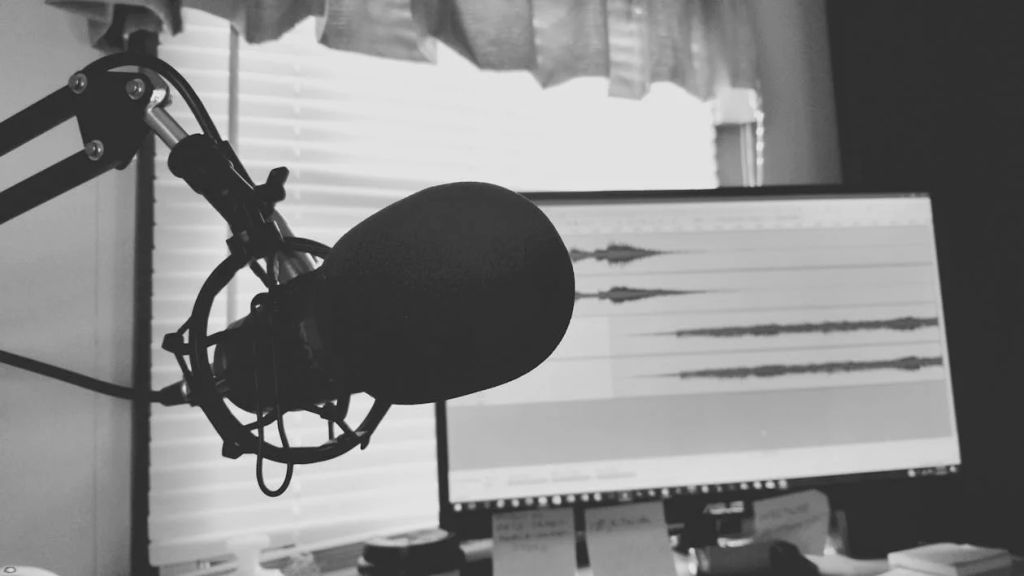
Kachina: “We love working with our speakers and our podcasters, because they have comfort on video. And I actually did a little bit of brief research: people don’t like the sound of their own voice because we pick up on some cues that we might judge and others—I sounded a little nervous when I said that, and now I’d hear it instead of feel it. So one is just getting comfortable being recorded.
Second is there is a difference podcast like in this interview format, a lot more conversational. So if we were to work out a podcast episode and we’re talking back and forth and it’s an hour long like most of them are, you probably transcribe that and go, All right, there’s five minutes of good content there, really glad. But we probably have to rerecord. It gets really dialed in.
But it’s great practice. You are ultimately using the course to build a relationship the same way you’re using the podcast to build a relationship, and it’s a shorter format, it’s just a different type of consumption, and it’s actually why people will probably pay more.”
The Value of Podcasts vs. Courses
Kachina: “I love listening to my favorite hosts. I’m not usually walking away an hour later with a to do list the same way that I get in a course. I have five to ten minutes and I walk away with a to do list.
There’s a different monetary value, at least right now. Doesn’t mean there’s any less information or any less relationship building, it just packaged differently, so it’s perceived differently and it serves different purposes.
There are plenty of times where I believe people will purchase courses similar to listening to a podcast, where they’re doing it just to skip the trust building process. I don’t have a podcast yet, but I have courses and programs. I use those courses and programs to build the trust so that somebody will upsell into a higher ticket program if that’s appropriate for them.
Whereas somebody who has a podcast and not a course, they’re using it for the same purpose, they’re just not monetizing it in the same way. So I think it’s serving the same function, it’s just packaged differently.
Because it’s packaged differently, it’s priced differently.”
Using Podcast Episodes as Bonus Content for Courses
Megan: I bought a course from a fellow expert in the podcasting industry recently, and he even hasn’t even had a podcast until very recently but he’s been providing such good information for so long and added so much value to the community.
I don’t think I even looked at the price before I put it in my cart and just checked out and bought it. I’ll buy anything he sells, because that much trust and relationship has been built over time.
I was thinking kind of in preparation for this conversation about other ways that I’ve seen people use kind of podcast episodes within content.
When you do have sort of a structured either group training program or evergreen course, podcasts can make really great bonus content and kind of extend discussions going beyond the actionable piece of information to maybe a more leisurely discussion or a more tangential piece of information.
Kachina’s thoughts on this strategy:
”I think that’s good. We’ve seen clients also do like audio meditations, so audio does make good bonuses. We did have a client put a podcast in the introduction. It was like this podcast episode was a great introduction to me and my story.
So that’s part of that relationship building where it came in early because they’re like, I could write a bio, but most people skim bios and a lot of experts don’t like writing them. This feel too self congratulatory.”
Megan: That is so true. Everyone hates writing their bio.
Conversational Podcasts for Nuanced Learning
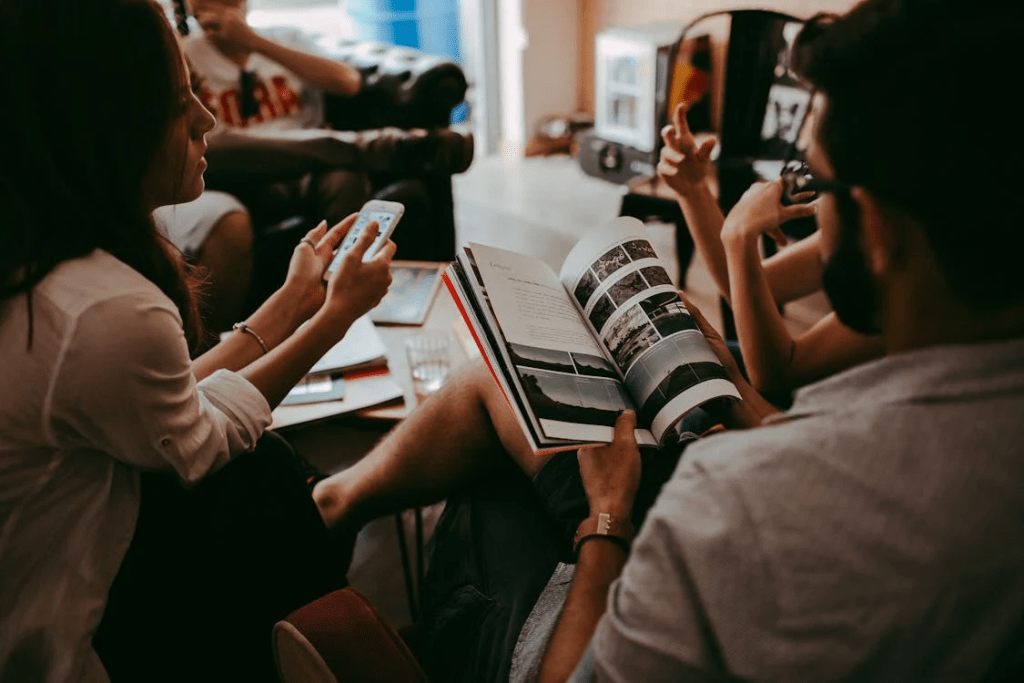
Kachina: “Using podcasts to kind of build a relationship, I like the deeper conversation because it’s conversational, you can get more nuances. I like it as an alternative to a lot of group coaching programs will sometimes have kind of like not guest experts, but community recordings.
I kind of like the idea of that also being an audio format. There is something to professionals being more casual getting into the nuances than, say, having a group coaching member share something vulnerable they might want to withhold. Because I do have some thoughts about whether or not that’s appropriate to resell and when it isn’t and when it is right.
It’s good to let people know that if they are sharing vulnerable stuff in a group coaching setting, whether or not that’s going to be part of a future product that’s available for sale. Because they might speak differently, but it typically allows you to get into that nuance and I do think that I’m an avid podcast listener and I’m an avid horse buyer.
I’d say I get as just as much educational value from both of them. I’d say that podcasts have less of the structure, so I have to be more intentional about Will I walk away and take action or did I just feel good because I heard what I should do?
It’s kind of like you can listen to your favorite fitness podcast; it’s not going to help you grow muscle. You do eventually have to pick up the weights and I think courses kind of go, Yeah, you can listen to me, but here are the weights and here’s where you buy them, and here are the reps. And that’s kind of like the difference between them.”
Education Beyond Completion
Kachina: “But that’s where education without action and that’s why we’re talking. It’s not only cheap, but it’s also kind of like a dopamine hit. So we can just enjoy consumer like binging content.
There are those avid course creators and one of the things that I also want to tell you, because of the way that we’re talking about courses is building relationship, building trust and part of a sales funnel, it’s nice to know how many people go through the program (it’s not necessary.)
Like I said, we’re not in college anymore, we’re adults, we have a lot of competing priorities. I launched this business in the middle of pandemic where I knew that people are undergoing a lot of emotional and family stress. It’s okay for people not to finish it.
They are listening to get the value. When they get the value, they may stop, and they may just choose to engage with you in a different way. And if that’s listening to your podcast for the next few years and implementing and gaining success, you can still have changed lives with or without a future transaction.”
Connect with Kachina Gosselin
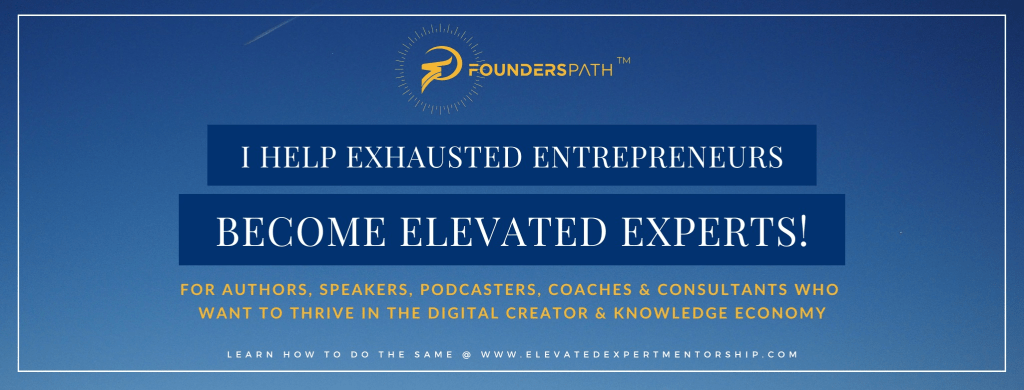
“A lot of my services, as you can tell, they’re very VIP and exclusive—that’s something that we’ve committed to.” – Kachina Gosselin
If you want to apply and get invited to either their group or private programs, you can visit elevatedexpertmastermind.com, fill out a short application, and they’ll let you know what’s best suited to you.
You can also find Kachina on Instagram!
Final Thoughts
I absolutely loved this conversation, and the lines that Kachina drew between creating content in different context, like social media or group programs or courses, and the different specific things you can do with it, like build relationships, engage your audience, build thought leadership, convert community members… sound familiar?
Using any of the Business Podcast Blueprints for your podcast sets you up for success in creating and selling scaled products and services – and vice versa!
It all exists within the framework of deciding the outcome you want for your business and making choices about your content to serve those goals, rather than employing a strategy because the strategy sounds good, or fun or easy or even profitable. The reality and objectives of the business need to come first.
We’ve linked to Kachina’s social media and website in the show notes, so make sure to check them out, and follow her for fantastic information.
Monthly Strategy & Networking Calls
This episode was originally a live Strategy and Networking call which we hold on the third Thursday of every month.
There was actually another 30 minutes of amazing discussion and Q and A with Kachina about how these ideas can be applied in different contexts and creating community – if you want to hear it, register for the calls, and you’ll have access to the recording.
Each one has a training and learning portion, followed by Q and A, hotseats for whatever you’re working on with your podcast, and a chance to network with other podcasters, industry professionals – they’re so much fun, and I’d love to see you there.
Learn more and register for free at PodcastingforBusiness.com/StrategyCalls or skip this and sign up using the form below!
[STRATEGY CALL REGISTRATION FORM]
Next Week on The Company Show
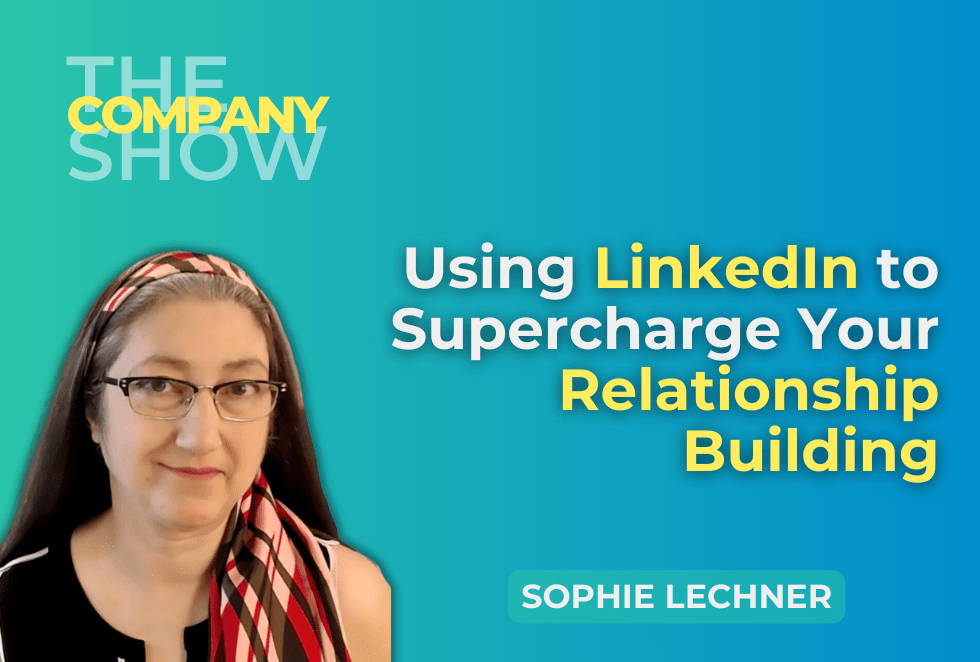
Using LinkedIn to Supercharge your Relationship Building
Next week we have an incredible call for you with Sophie Lechner, creator of the Magnet Model for LinkedIn.
We covered a lot of ground, but here is one of my favorite parts where Sophie is talking about the many, many ways you can create valuable content for social media for every episode you create:
You’re going to learn so much from this conversation and probably have a long to-do list of process changes to make to enhance your relationship building—just like I did!
Make sure you’re subscribed to hear the whole thing.
Need A Podcast?
As always, this is Megan Dougherty, and The Company Show was made possible by the team at One Stone Creative.
If you know a business owner that you think should have a podcast, do us a favor and send them to podcastingforbusiness.com!
Key Quotes
“I don’t want to be intimidating at all, but I think we do just have to acknowledge those harsh realities, that a course is a really advanced product to sell.” – Kachina Gosselin
“The standard for what is expected for an audiovisual product. It’s getting higher every year—here are fewer and fewer excuses.” – Megan Dougherty
“Simple is not easy.” – Kachina Gosselin
Resources
One Stone Creative | LinkedIn | Twitter | Facebook | Instagram
Make sure to check out our free Monthly Strategy Calls!
Podcasting for Business Conference 2023 Recordings
Learn about what other business podcasters are doing:
Kachina Gosselin Website | Instagram | LinkedIn
Sophie Lechner Website | LinkedIn
Related:
- Should You Make an Online Course?
- How to Outline a Podcast, Book or Course in an Afternoon
- Learning From Experts
PFBCon 2023 Recordings
Whether you’re a solopreneur, manager of a department, principal at a firm, or a non-fiction author ready to expand into audio, the Podcasting for Business Conference will help you leverage a podcast to meet your business objectives.
Missed PFBCon 2023? Check out the recordings!

